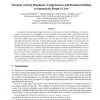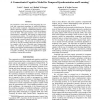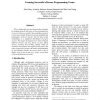19 search results - page 2 / 4 » Towards Understanding and Harnessing the Potential of Clause... |
IJCNN
2008
IEEE
14 years 2 months ago
2008
IEEE
—A novel wake-sleep learning architecture for processing a robot’s facial expressions is introduced. According to neuroscience evidence, associative learning of emotional respo...
DEBU
2006
13 years 7 months ago
2006
Automated reasoning about human behavior is a central goal of artificial intelligence. In order to engage and intervene in a meaningful way, an intelligent system must be able to ...
AAAI
2007
13 years 10 months ago
2007
The importance of the efforts towards integrating the symbolic and connectionist paradigms of artificial intelligence has been widely recognised. Integration may lead to more e�...
IROS
2007
IEEE
14 years 1 months ago
2007
IEEE
— Any system that has the capability to diagnose and recover from faults is considered to be a fault-tolerant system. Additionally, the quality of the incorporated fault-toleranc...
AGILEDC
2006
IEEE
13 years 11 months ago
2006
IEEE
XP is a lightweight process that provides principles for guiding projects and relies on the participants for its success. However, despite these guidelines, projects can be unsucc...



